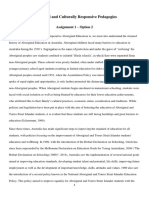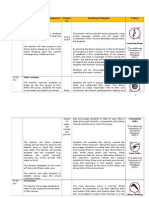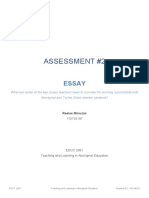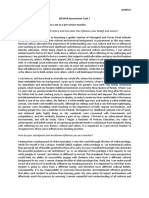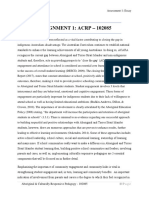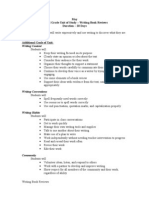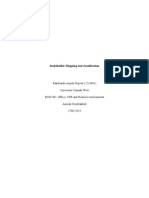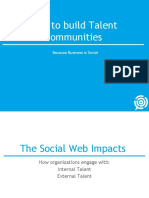Assessment 3 Learning Plan Template Bush Tucker
Assessment 3 Learning Plan Template Bush Tucker
Uploaded by
api-248449212Copyright:
Available Formats
Assessment 3 Learning Plan Template Bush Tucker
Assessment 3 Learning Plan Template Bush Tucker
Uploaded by
api-248449212Original Title
Copyright
Available Formats
Share this document
Did you find this document useful?
Is this content inappropriate?
Copyright:
Available Formats
Assessment 3 Learning Plan Template Bush Tucker
Assessment 3 Learning Plan Template Bush Tucker
Uploaded by
api-248449212Copyright:
Available Formats
Assessment 3: Digital Portfolio Learning Plan Template
Early Learning Environment Required Headings Name of Experience Description example Bush Tucker The children will learn what foods were available to local Indigenous Australians and try some of the foods. The children will learn the Kaurna names for the food, create a chart and also participate in preparing some of the foods in recipes. This exercise will be led by a local Indigenous leader (incursion or excursion). 3- 5years of age The experience will introduce children to Indigenous cultural ways regarding plants and animals as food for eating and medicinal purposes. The children will meet local Indigenous leaders, list different types of foods, learn how the foods are collected, taste a variety of foods, develop an understanding of the connection of food and the environment and cultural practices. Introduce local Indigenous leader and discuss where Indigenous Australians live and who the local Indigenous community are around school area. Discuss and be shown, various items for collecting food. Discuss who was responsible for finding the food and the preparation of the food. Discuss why this was important within the culture. Also discuss diet and how that has changed during the course of history and how this has affected the Indigenous community today. Children can try some of the foods available, prepare the foods and then learn the Indigenous words for the food. A food chart can also be created, showing if the food is for eating or medicinal, if it is plant or animal based. Children can then draw a picture of their experience, using the local language for the foods and share with the class or part of a whole of school assembly. Rationale This experience will provide an opportunity for the students to gain an understanding and appreciation for the culture and traditions of Indigenous Australians through a common theme, food. According to the Australian Curriculum, Assessment and Reporting Authority (2013), there must be links to Country/Place, Peoples and Cultures. This exercise discusses the links to country by examining the foods from earth and their connection to their own land (country/place), their connection to healing (cultures) and also, who is responsible for the collection of foods (peoples). The Melbourne Declaration on Educational Goals for Young Australians, (2008) also discusses that schools build on local cultural knowledge and experience of Indigenous students as a foundation for learning, and work in partnership with local communities on all aspects of the schooling process, including to promote high expectations for the learning outcomes of Indigenous students. By connecting with the local community, the students will be able to understand from a cultural perspective, the role food plays in
EDU10005SO Indigenous Education and Perspectives
Age group Description
the Indigenous culture. It promotes an interest in local community perspectives and provides an opportunity for the students to connect with the local community. The Early Years Learning Framework (EYLF) also suggests that learning should be physical, social, spiritual, creative and consider linguistic aspects. Through being able to touch the food and food collection items (physical), working together in a group (social), connections to the land (spiritual), making food together and a food chart (creative) and linguistic (learning the Indigenous terms for food), this exercise covers the suggestions in the EYLF. Resources Guest speaker Indigenous leader from the community Coloured pens, crayons, coloured pencils, paint, brushes, paper Pictures of traditional food Digital camera for incursion/excursion Permission forms for incursion/excursion Food preparation items (such as bowls, aprons, spoons, food) Chart Australian Guide to Healthy Eating downloaded from http://www.eatforhealth.gov.au/guidelines/australian-guide-healthyeating Book Waterlillies Diane Elizabeth Lucas
Introduction Start the experience with a story, describing what exactly happens when looking for bush tucker. This will provide an opportunity for the students to sit and listen to an Indigenous perspective of food gathering. Students will be invited to ask questions to demonstrate their current knowledge and understanding. Strategies Invite children to participate Use a strength based approach that focuses on positive aspects of Indigenous culture Encourage children to explore options though the program solving questions and dilemmas that explore cultural disharmony, droughts Making connections to what they already know and new experiences Develop an interest in Indigenous cultures and understanding the environment from an Indigenous perspective Learning from others through relationships and interactions Ask questions to form an understanding of the topic Interacting with others through listening and questioning and showing respect for visitors Reflect on what they have learnt through simple assessment such as drawing their interpretation of the days events Identify healthy food choices through the use of the food chart Understand the role members of the family / community in Indigenous and non-indigenous cultures through the story telling Conclusion As children leave the experience suggest that they extend the learning by sharing the story that they have created with their own families, discussing the role of the family members and community in the food gathering process. If available, share the food samples with their family, discussing what they liked, what they didnt like. Taking home a recipe with enable the children to share the experience with their family as well.
EDU10005SO Indigenous Education and Perspectives
You might also like
- EDU10004 A3 Template 2023 Final Draft With ScreenshotDocument11 pagesEDU10004 A3 Template 2023 Final Draft With ScreenshothiyamziyadNo ratings yet
- Educ4132 ExamDocument17 pagesEduc4132 Examapi-357680810No ratings yet
- 14285985lauren McgrathDocument10 pages14285985lauren Mcgrathapi-411050747No ratings yet
- Part A: Scenario 1: RileyDocument10 pagesPart A: Scenario 1: Rileythunguyenhoang0303No ratings yet
- Aboriginal and Culturally Responsive Pedagogies Assignment 1Document8 pagesAboriginal and Culturally Responsive Pedagogies Assignment 1api-332411347No ratings yet
- UNIT: EDU20003 Contemporary Perspectives of Learning and Development Assessment 2Document12 pagesUNIT: EDU20003 Contemporary Perspectives of Learning and Development Assessment 2thunguyenhoang0303100% (1)
- Position Paper - Inclusive PracticeDocument5 pagesPosition Paper - Inclusive Practiceapi-339522628No ratings yet
- Edss341 Unit Plan EdfdDocument20 pagesEdss341 Unit Plan Edfdapi-455597246No ratings yet
- Aboriginal and Culturally Responsive Pedagogies Assignment 1-Essay Option OneDocument6 pagesAboriginal and Culturally Responsive Pedagogies Assignment 1-Essay Option Oneapi-435781463No ratings yet
- Assignment 1: Aboriginal Education (Critically Reflective Essay)Document11 pagesAssignment 1: Aboriginal Education (Critically Reflective Essay)api-355889713No ratings yet
- My Lesson FinalsDocument7 pagesMy Lesson Finalsapi-321156981No ratings yet
- Edab Ass 1Document2 pagesEdab Ass 1api-298379083No ratings yet
- DTL Assessment 1 - FinalDocument8 pagesDTL Assessment 1 - Finalapi-505912741No ratings yet
- Editrossetti A 255144 Est 203 Assignment 2Document4 pagesEditrossetti A 255144 Est 203 Assignment 2api-296874733100% (1)
- Final Edu10002so Understanding Language and Literacy Fiona Pidgeon Assessment 3 PortfolioDocument7 pagesFinal Edu10002so Understanding Language and Literacy Fiona Pidgeon Assessment 3 Portfolioapi-248449212No ratings yet
- Individual Reflection 17456933Document6 pagesIndividual Reflection 17456933api-518663142No ratings yet
- Empowering Parents & Teachers: How Parents and Teachers Can Develop Collaborative PartnershipsFrom EverandEmpowering Parents & Teachers: How Parents and Teachers Can Develop Collaborative PartnershipsNo ratings yet
- Assignment 1 - 102085Document10 pagesAssignment 1 - 102085api-357692508No ratings yet
- Critically Reflective EssayDocument9 pagesCritically Reflective Essayapi-478766515No ratings yet
- Howe Brianna 1102336 Task1 Edu202Document8 pagesHowe Brianna 1102336 Task1 Edu202api-457440156No ratings yet
- EssayDocument13 pagesEssayapi-361229755No ratings yet
- Aboriginal Culturally Responsive PedagogiesDocument2 pagesAboriginal Culturally Responsive Pedagogiesapi-3576833510% (1)
- Primary Science Year 2 FPDDocument25 pagesPrimary Science Year 2 FPDapi-451099210No ratings yet
- Edcu At2 EssayDocument5 pagesEdcu At2 EssayChloe NajemNo ratings yet
- Assessment 2 - Unit PlanDocument19 pagesAssessment 2 - Unit Planapi-519322453No ratings yet
- One TeacherDocument7 pagesOne Teacherapi-235065651100% (1)
- Aboriginal and Culturally Responsive PedagogiesDocument7 pagesAboriginal and Culturally Responsive Pedagogiesapi-379378935100% (1)
- What Are Some of The Key Issues' Teachers Need To Consider For Working Successfully With Aboriginal and Torres Strait Islander Students?Document4 pagesWhat Are Some of The Key Issues' Teachers Need To Consider For Working Successfully With Aboriginal and Torres Strait Islander Students?api-465449635No ratings yet
- English Recount LessonDocument9 pagesEnglish Recount Lessonapi-451036143No ratings yet
- Standard 2 4 EvidenceDocument8 pagesStandard 2 4 Evidenceapi-324752028No ratings yet
- Critically Reflective EssayDocument7 pagesCritically Reflective Essayapi-460524150No ratings yet
- Acrp Essay - Assessment 1Document13 pagesAcrp Essay - Assessment 1api-368764995No ratings yet
- Final EssayDocument6 pagesFinal Essayapi-375391245No ratings yet
- Academic Essay. Written Reflections & Critical AnalysisDocument4 pagesAcademic Essay. Written Reflections & Critical AnalysisEbony McGowanNo ratings yet
- Assignment 3 Hass Unit PlanDocument8 pagesAssignment 3 Hass Unit Planapi-626567329No ratings yet
- Assessment 2 - Case Study: Stephanie ChristelowDocument10 pagesAssessment 2 - Case Study: Stephanie Christelowapi-457784453100% (1)
- AboriginalDocument9 pagesAboriginalapi-357683351No ratings yet
- Assessment 1: Aboriginal Education: Reflective EssayDocument8 pagesAssessment 1: Aboriginal Education: Reflective Essayapi-332298416No ratings yet
- Adolescent Development and TeachingDocument1 pageAdolescent Development and Teachingapi-461572829No ratings yet
- Acrp ReflectionDocument7 pagesAcrp Reflectionapi-429869768No ratings yet
- Snell Kristya2Document11 pagesSnell Kristya2api-248878022No ratings yet
- Activity Plan 0 To 3 YearsDocument3 pagesActivity Plan 0 To 3 Yearsapi-357680810No ratings yet
- Aboriginal - Assignment 1 2Document9 pagesAboriginal - Assignment 1 2api-478678504No ratings yet
- EDU30064 Teaching Science - FolioDocument15 pagesEDU30064 Teaching Science - FolioMarnie JanineNo ratings yet
- 7 2 1 - Aboriginal and Culturally Responsible PedagogyDocument6 pages7 2 1 - Aboriginal and Culturally Responsible Pedagogyapi-321023194No ratings yet
- Edu410 Reflective PortfolioDocument8 pagesEdu410 Reflective Portfolioapi-412566974No ratings yet
- Inquiry UnitDocument25 pagesInquiry Unitapi-281926370No ratings yet
- Aboriginal and Culturally Responsive Pedagogies Assessment 1Document9 pagesAboriginal and Culturally Responsive Pedagogies Assessment 1api-321128505No ratings yet
- Evana Loucas 110163317 Hass Assignment 2 Unit PlanDocument21 pagesEvana Loucas 110163317 Hass Assignment 2 Unit Planapi-297230954100% (2)
- Edfd452 Evidence - Edss341 A3Document21 pagesEdfd452 Evidence - Edss341 A3api-358837015No ratings yet
- 2h Reflection MurgoloDocument6 pages2h Reflection Murgoloapi-368682595No ratings yet
- EDU30001 LiteracyDocument10 pagesEDU30001 Literacynaima fadilyyt7i8 please 0tlNo ratings yet
- Acrp Assessment 2 EssayDocument9 pagesAcrp Assessment 2 Essayapi-533984328No ratings yet
- Aboriginal Assignment 1 FinalDocument10 pagesAboriginal Assignment 1 Finalapi-357661397No ratings yet
- Rimah Aboriginal Assessment 1 EssayDocument8 pagesRimah Aboriginal Assessment 1 Essayapi-376717462No ratings yet
- Edfd452 Evidence - Edss341 A3Document21 pagesEdfd452 Evidence - Edss341 A3api-358837015No ratings yet
- 2h 2018 Assessment1 Option2Document7 pages2h 2018 Assessment1 Option2api-355128961No ratings yet
- Unit 102082 Philosophy of Classroom Management Document R 1h208Document17 pagesUnit 102082 Philosophy of Classroom Management Document R 1h208api-374359307No ratings yet
- Jane Sparrow 20144178Document14 pagesJane Sparrow 20144178api-393907178No ratings yet
- Klaryse Dam - Essay On The Foundation of Teaching and LearningDocument12 pagesKlaryse Dam - Essay On The Foundation of Teaching and Learningapi-505539908No ratings yet
- Assessment One - AboriginalDocument13 pagesAssessment One - Aboriginalapi-357662891No ratings yet
- 2014-2-Edu20005 Sustainable Education and Perspectives Assessment 3 Folio Final Fiona Pidgeon 657999xDocument16 pages2014-2-Edu20005 Sustainable Education and Perspectives Assessment 3 Folio Final Fiona Pidgeon 657999xapi-248449212100% (2)
- Edu20002 Final Document Assessment 3 Folio Fiona Pidgeon 657999xDocument25 pagesEdu20002 Final Document Assessment 3 Folio Fiona Pidgeon 657999xapi-248449212100% (7)
- Fiona Pidgeon 657999x 2014-2-Edu30002 Science and Technology Assessment 2 Folio FinalDocument21 pagesFiona Pidgeon 657999x 2014-2-Edu30002 Science and Technology Assessment 2 Folio Finalapi-248449212100% (3)
- Fiona Pidgeon 657999x Assessment 1a Essay Scoping Teaching and Learning in 21st Century FinalDocument7 pagesFiona Pidgeon 657999x Assessment 1a Essay Scoping Teaching and Learning in 21st Century Finalapi-248449212100% (1)
- Persisting Mini LessonDocument3 pagesPersisting Mini Lessonapi-379755793No ratings yet
- Perception On The Impact of New Learning Tools in Humss StudentDocument6 pagesPerception On The Impact of New Learning Tools in Humss StudentElyza Marielle BiasonNo ratings yet
- Unit Plan ReviewsDocument6 pagesUnit Plan ReviewslisamloomisNo ratings yet
- ODI 21 Class 9 TeamsDocument50 pagesODI 21 Class 9 TeamsNimit DasNo ratings yet
- Welcome: Click On The Link To Watch The Video Podcast: - Password: Online3cuiDocument2 pagesWelcome: Click On The Link To Watch The Video Podcast: - Password: Online3cuimiguelsaltaNo ratings yet
- Works CitedDocument4 pagesWorks Citedapi-242472543No ratings yet
- Unit 4 Task 4 MarianogonzalezoriettagutierrezDocument5 pagesUnit 4 Task 4 Marianogonzalezoriettagutierrezapi-237575843No ratings yet
- E-Tech Module TrueDocument195 pagesE-Tech Module TrueMa'am Digs VlogNo ratings yet
- Marking, Sections & Techniques 2014Document1 pageMarking, Sections & Techniques 2014Arturo GallardoNo ratings yet
- Mobileapp Design: Software Engineering: A Practitioner'S Approach, 8/EDocument15 pagesMobileapp Design: Software Engineering: A Practitioner'S Approach, 8/EalbertosalesNo ratings yet
- Stakeholder MappingDocument5 pagesStakeholder MappingAqeela NajeebNo ratings yet
- Unit 1: What S Your E-Mail Address?Document27 pagesUnit 1: What S Your E-Mail Address?Juan FredieNo ratings yet
- Regular & Irregular Verbs PDFDocument186 pagesRegular & Irregular Verbs PDFsaqib aliNo ratings yet
- The System of Grammatical Categories of The Verb: Person and Number, Tense, Aspect, Voice, MoodDocument4 pagesThe System of Grammatical Categories of The Verb: Person and Number, Tense, Aspect, Voice, MoodАна БдоянNo ratings yet
- General English Mock Lesson GuidelinesDocument2 pagesGeneral English Mock Lesson GuidelinesDimitarNo ratings yet
- Grand Test/Quiz: Govt. Postgraduate College Mandian AbbottabadDocument7 pagesGrand Test/Quiz: Govt. Postgraduate College Mandian AbbottabadAnonymous s1iaEulaNo ratings yet
- Bod Critique Bu 362 T1 - Group 4: Areas of ImprovementDocument4 pagesBod Critique Bu 362 T1 - Group 4: Areas of ImprovementAPURV SHARMANo ratings yet
- How To Build Talent Communities: Because Business Is SocialDocument28 pagesHow To Build Talent Communities: Because Business Is SocialSumit KumarNo ratings yet
- The State of Mobile in Rural Vietnam ReportDocument24 pagesThe State of Mobile in Rural Vietnam ReportOne Piece ワンピースNo ratings yet
- AP Spanish Literature and Culture Course and Exam Description, Effective Fall 2020Document4 pagesAP Spanish Literature and Culture Course and Exam Description, Effective Fall 2020Loira OrtizNo ratings yet
- Indian Newspaper Readership and The Impact of COVID-19: A Case of Dainik BhaskarDocument4 pagesIndian Newspaper Readership and The Impact of COVID-19: A Case of Dainik BhaskarIJELS Research JournalNo ratings yet
- Open WRTDocument6 pagesOpen WRTAhmedNo ratings yet
- Q1-M4-Examining Oral Communication ActivitiesDocument51 pagesQ1-M4-Examining Oral Communication ActivitiesCrystal Faith CamomotNo ratings yet
- Internet: Ravi BhushanDocument53 pagesInternet: Ravi Bhushangparekh4uNo ratings yet
- #Shuaib RMCT AssignmentDocument9 pages#Shuaib RMCT Assignments_dark155No ratings yet
- Unit 1 Higher TestDocument3 pagesUnit 1 Higher TestLjiljana Radjenovic100% (1)
- DMIT Business Opportunity-I D ADocument3 pagesDMIT Business Opportunity-I D AvishwwaNo ratings yet
- Narrative Report (INSET)Document2 pagesNarrative Report (INSET)Rona Regine T. Vargas86% (7)
- BM564 PR1 Assignment Brief 31.03Document5 pagesBM564 PR1 Assignment Brief 31.03constantin timplarNo ratings yet
- Consumer Buying Behavior: India AirlinesDocument25 pagesConsumer Buying Behavior: India AirlinesPriyanka JainNo ratings yet




